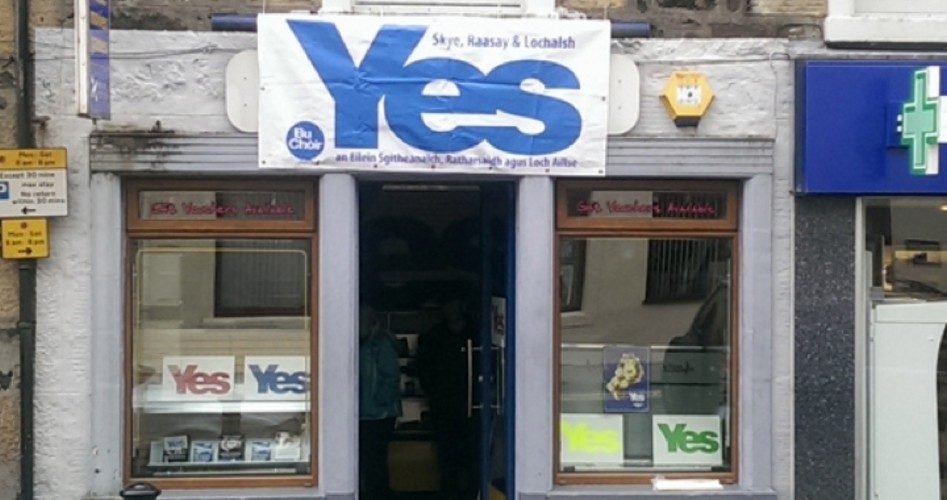
The final reported totals from Scotland’s September 18 vote asking, “Should Scotland be an independent country?” were 2,001,926 (55 percent) No and 1,617,989 (45 percent) Yes.
A number of people have questioned the results:
• Russian election observer Georgy Fyodorov was quoted on Alex Jones’ Infowars website as saying, “According to what our observers at the polling offices tell us, there were more Yes votes during the vote count.”
• A YouTube video claims to show election workers sorting the Yes and No ballots with one worker switching ballots from a Yes stack to a No stack, stacks of ballots left unattended on a table marked No with ballots marked Yes on the table, and an individual who appears to be an election worker marking ballots.
• Ben Swann’s website reported that Glasgow police are investigating 10 possible incidents of vote fraud based on reports of voters showing up at the polls and being told they had already voted.
• An online petition saying, “We the undersigned demand a revote of the Scottish Referendum, counted by impartial international parties” has more than 90,000 online signatures.
How Credible Are the Doubts?
With an election of any size, there will always be some people who doubt the outcome. The statements of doubt by some official observers in this election do add credibility to such concerns. Alleviation of doubt is the reason why traditional American elections were governed by election laws that required openness. Anyone in the United States who was concerned about possible electoral fraud was welcome to observe the process from start to finish: voter check-in, the casting of ballots, and even the vote counts. Observers were not even required to obtain permission ahead of time. These procedures, when followed, generally resulted in accurate and honest elections that were verifiable by the public.
British elections were at one time even more open than U.S. elections, because they used the viva voce method (Latin for “live voice”) — voting by speech, as distinguished from voting by a written or printed ballot. However, U.K. elections are no longer based on the transparent process they once were. The U.K. Electoral Commission’s Media Handbook for this election explains under Section 10.3, “How are the votes counted?”
At the close of poll, sealed ballot boxes and any postal votes handed in to polling places are collected and transported to the count venue.
Once all the ballots have been counted and adjudicated the Counting Officer will relay the local total to the Chief Counting Officer who will confirm the figures before authorising the declaration of the local total.
The Chief Counting Officer will collate the local totals from each local count. Once all the 32 local totals have been received, confirmed and collated the Chief Counting Officer will be able to declare the referendum result.
The instructions required the vote totals and subtotals to be kept secret until the chief counting officer had received all of them.
These vote-counting procedures are frighteningly similar to those employed by Adolf Hitler and Joseph Stalin. For example, in Nazi Germany the Propaganda Ministry held centralized control over the vote totals and released election results to the public and the press only after all the vote totals were reported to the central authority. That’s how Reich Propaganda Minister Joseph Goebbels was able to ensure all election results were what officials wanted them to be before the German people were allowed to know even their own local results.
Regarding the dangers of counting ballots at counting centers rather than at the precincts, U.S. Ambassador Arthur Bliss Lane caught Stalin’s agents cheating in the Polish referendum of June 30, 1946. Lane wrote in his book I Saw Poland Betrayed how, although ballots were supposed to be counted at the precincts, the security police gave illegal orders to have the ballot boxes shipped to the district commissioner’s headquarters before they were counted.
Ambassador Lane had this to say about the vote counts that occurred behind closed doors:
On the controversial question of the abolition of the Senate, the government claimed a victory of over eighty per cent; whereas, according to figures which our observers compiled independently of one another, the opposition voted No in approximately the same percentage.
The ballot boxes in the Scottish independence election were to be sealed before shipment. Sealing the ballot boxes does add slightly to the security; however, seals are man-made and can be forged. There are numerous other bypasses to affixing the seals. They can be used for fixing an election via an inside job. The most dangerous point about transporting ballots before counting them is that so much of the handling is done behind closed doors by government employees or government appointees. So unless someone who was directly involved in an electoral fraud steps forward and confesses, the only evidence available to the public will be circumstantial.
Were Yes Votes Swapped With No Votes?
Many concerns have been raised by a YouTube video that depicts a number of suspect activities, including a vote counter allegedly moving a number of Yes votes to a stack of No votes. The video does not identify at which counting center the video was taken, at what time, by whom, how the photographer gained access to the vote-counting center, or contact information for verification.
A spokesman for Chief Counting Officer Mary Pitcaithly responded to this YouTube video that depicts a number of Yes votes being placed in a stack of No votes. The spokesman raised the possibility that the ballots were initially put in the wrong pile and the vote counter might have been merely correcting a mistake. The spokesman also voiced concerns similar those mentioned in the paragraph above regarding who took the video and where and when it was taken.
The YouTube video shows vote counters seated next to each other, but working individually. However, it is a common practice in manual vote counting for counters to work in pairs or threes, preferably teamed up with people from opposing sides. There are some photos of the vote counting in this election that clearly show the counters in teams of two or three working together rather than separately.
The New American contacted the chief counting officer’s office via their press contact procedures regarding questions about the counting of the votes; however, there was no response by press time.
Was There Vote Fraud Via Impersonation?
Glasgow police are investigating 10 cases of suspected of impersonation. Ten voters showed up at the polls in Glasgow and were told their names had already been crossed off the list for having voted. Ten votes by themselves are not enough to change the outcome of the election. It’s even possible these might be clerical errors rather than fraud. However, an investigation is necessary because these votes might be just the tip of the iceberg of repeat voters. Because there is no requirement for voters to show ID; repeaters need only make a verbal statement of who they claim to be. Colin Edgar of the Glasgow City Council was quoted on the Ben Swann website as saying:
We know which boxes those votes went into and we know the numbers on the votes, so the police have asked us to identify those votes, to take them away, keep them for evidence and hand them to them.
This statement is disturbing because it indicates that the ballots were not truly secret. In a genuine secret ballot election the voters’ choices are secret, and how the government processes them is open to the public. But in Glasgow the procedure was the exact opposite. At least one news report has a photo of an impounded ballot: It appears to have an ID number on it.
Hopefully, the Glasgow police investigation will not focus solely on the 10 incidents that have been reported. Electoral fraud is generally perpetrated by highly intelligent people. If there was widespread repeater voting, the planners would likely have been careful to use the names of either those who rarely vote or non-existent persons. The best way to investigate fraudulent voting by repeaters is by contacting voters who are listed as having voted. The investigation should be conducted in Glasgow and other locations as well. It’s possible the impersonation was conducted in numerous locations, and Glasgow was the only place it was detected.
How Credible Are the Proposed Solutions?
The most visible proposed solution is an online petition calling for a revote with the votes counted by pairs of vote counters — “one of whom should be an international party without a stake in the vote.” However, even if impartial international observers could be found, which is doubtful, this is a classic case of good intentions coupled with a solution that misses the mark.
Why look for foreigners to be part of the vote count? Just open the process and let the Scottish voters observe the vote count right at the precincts where the ballots were cast. If the election officials want to transport the votes to counting centers for centralized recounts, that’s fine, just as long as the ballots are counted first in public at the precincts and the totals reported to the public before the ballots are transported.
There is absolutely no improvement to security by keeping vote totals secret as they are being counted and accumulated. The only purposes served by this method are 1) building a media event for whoever announces the election results, and 2) providing an opportunity for someone to commit fraud behind closed doors.
Counting the votes at the polls immediately after closing would also provide a quicker vote count, probably no longer than an hour. It would not be necessary to count the votes during the night even if the authorities wished to close the polls at 10:00 p.m., although closing the polls an hour or two earlier would make it easier for the public to monitor the vote count.
The leading method of combating voter impersonation is a voter ID law. However, this may be an opportune moment to suggest an idea of MIT Professor Ron Rivest. Speaking at the Election Integrity Past, Present and Future symposium at MIT on October 1, 2011, Rivest proposed using video cameras at the polls. Each voter would simply state his or her name and the intention to vote, taking approximately 10 seconds each. The camera would automatically record the date and time along with the location. No one would need an ID and there would be no need to invade the privacy of the voters by recording the ballot IDs, except for provisional ballots. If impersonation is discovered, there will be a photo of the impersonator.
There is much that can be done without resorting to international observers. Reformers should concentrate on the electoral process. The solutions to doubts about the recent Scottish independence election are not to be found by looking outside the U.K. It’s time to reinstate some basics, such as counting the votes at the precincts immediately after closing the polls, and allowing the public to witness their own ballots being counted.
Photo of “Yes” vote signs: “Yes Scotland 2014 – geograph.org.uk – 4135401” by John Allan



